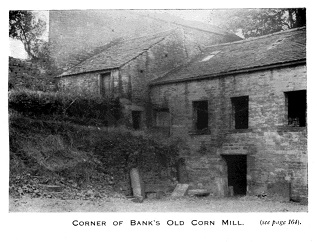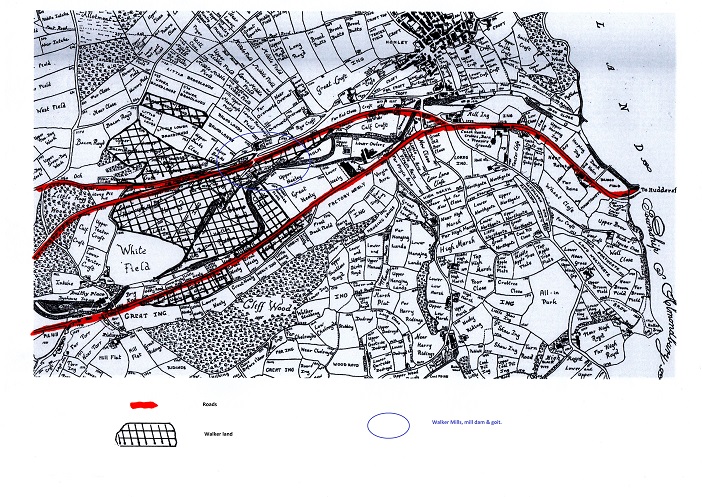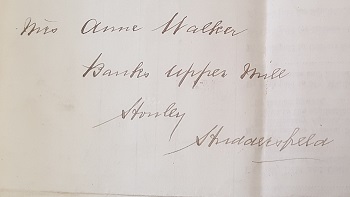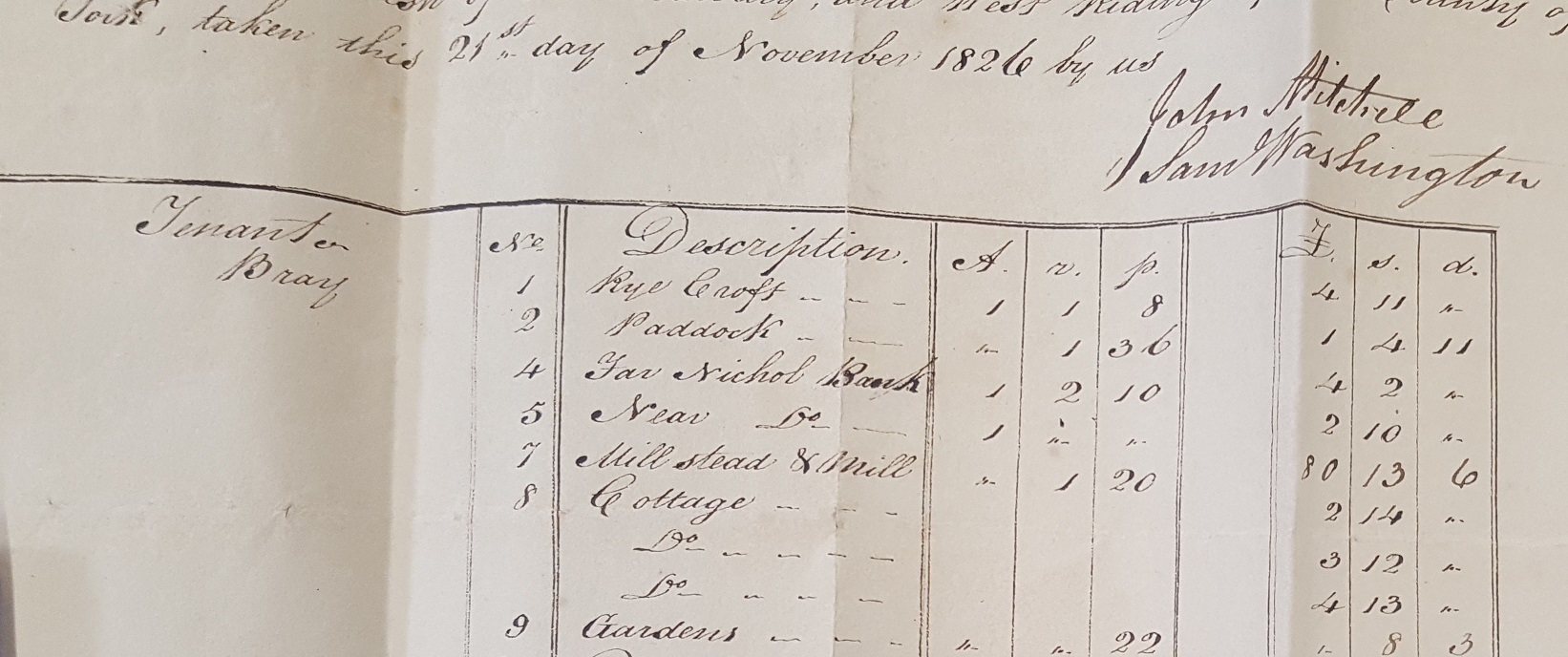The Walkers of Lightcliffe Honley properties.
There are records in the West Yorkshire Archive indicating several properties in Honley including 2 mills. By 1838 these are shown to be in Ann Walker’s name.
The family connection and, presumably, the reason why the property came into the family is that William Walker of Lightcliffe married Elizabeth Haigh in 1708 or 1709 and this property was her dowry. They had 4 children, Elizabeth (1710), Sarah (1711), William (1713) and Haigh (1714). All were baptised at St Matthew’s Lightcliffe. William married Elizabeth Caygill after his first wife died. Their son, John, inherited his estate including the properties in Honley. He bequeathed these to his daughter Ann. When he died, his son John inherited the bulk of the estate though his daughters had some property settled on them in their own right. John died in 1832 and his sister inherited his estate jointly.
An Indenture dated 1st January, 1768 between William Walker of Crownest Halifax; to Joseph Armitage and Joseph Jagger of Honley. Each of the three should contribute equally to the cost of building a ‘Mill or Mills for the crushing of Rapes with sufficient Granaries storehouses and other buildings and improving the Fulling mill there now standing’.
The estimated cost of doing these was £500. Armitage and Jagger were to rent the premises from Walker by paying him a sum equal to the interest on the moneys he would have earned had it been invested, plus a fee of £5 per hundred (5%) for a term of 42 hears. That would have taken the arrangement up to 1810. The fulling mill and house barns and other buildings was already rented to Joe Jagger. They were previously occupied by Abraham Roberts.
The indenture also included permission to build ‘a Rasp or other engine on the premises for cutting, clipping rasping or grinding dyed wool.
Power for the new Rape mill was to be taken from the water wheel in the fulling mill.
In 1826 the Walker’s land agent, Samuel Washington undertook an evaluation of the Honley property with a John Mitchell. Each property was given a rental value which totalled £509. In Sam Wormald’s inventory of 1838 most, or all, of these properties were still in the hands of Ann Walker and lay on either side of the river between the 2 roads leading to Brockholes and Holmfirth.
The following entry from Anne Lister's diary for 21st August 1837.
"Alighted at Mr. John Haigh’s, at Honley, at 6.50 (tenant to Ann for her Honley Mills, and to Lord Dartmouth for a profitable colliery). Drove through Huddersfield and Halifax and at home at 9.50.”
Ann was declared a lunatic in 1843 and initially her affairs were conducted by her brother in law, George Mackay Sutherland from Shibden Hall where Ann had been living with Anne Lister until the latter’s death. He was referred to as ‘The Committee’. When he died in 1847, Samuel Washington produced a very detailed set of accounts for this period 1843 to 1847. Included in this is annual income for ‘Honley Mills’ of £320 per year. If Washington used a similar method of summary as for some other properties it is likely that this phrase includes property other than just the mills. There would be a separate accounts book from which this total was transferred. The mills were run by the Haigh family with John Haigh responsible for paying the rents of the mills in 1845 [see below].
The Chief rent for the properties was owed to Lord Dartmouth. For the period 1803 to 1827, John Walker paid £1.11.3 at 1/3 per annum. In March 1846 this Chief Rent was paid for 15 years amounting to 18s 9p. There’s a further entry in Washington’s accounts for payment to a George Robinson of a Chief Rent of £3.16.0 on Bank’s Estate, Honley.
There are 3 pages of detail on the estate but it is undated. It includes what looks like a valuation of £7,700 including £680 for one mill and £2750 for the other.
The owner of the Mill in 1853 as reported by The Holme Reservoir Commissioners was Anne Walker. The Upper Mill (woollen) was damaged in the Great Holmfirth Flood of 1852. The occupant of the Lower Mill was William Cross Robinson, later Joseph Sutcliffe in February 1856 
After Ann’s death in 1854, her nephew Evan Charles Walker inherited her estate. Her will granting this stipulated that he added Walker to his surname. For a number of years he was known as Sutherland Walker but by Act of Parliament he was allowed to drop this and he began to sell off many of his properties both in Lightcliffe and elsewhere around Halifax and Huddersfield at the end of 1860s when he moved to Skibo Castle in the north east of Scotland. Eventually as he ran out of money, he sold the castle to Andrew Carnegie.
EC Walker and John Smith, his land agent, were visiting Honley in both 1868 and 1869. If it related to the sale of the properties, no evidence has yet been seen as to the outcome. One of the mills was destroyed by fire and they fell into disrepair. The land was sold to john Mellor in 1890 who opened a Pleasure Ground called Hope Bank.
The 1826 valuation by Washington and the Wormald inventory are very similar. There were 56 acres involved. The number of items falls from 54 to 45 but Washington lists individual cottages and Wormald plots.
The estate included a woollen mill, a corn mill, a mill dam and goit, a small reservoir, paddocks, cottages, gardens, barns, a stone yard and waste land.

The following are examples of the sources. For details please contact Ian Philp via www.lightcliffechurchyard.org.uk
A folded envelope addressed to Ann Walker at one of the mills.

Extract from Samuel Washington’s accounts to the Committee in 1847.

Extract from the 1826 valuation.

The Walkers also had an interest in the Holme Reservoirs, presumably to guarantee a water supply to the mills. The reservoir company was writing to S Washington in 1846 regarding the advantages of building more reservoirs in Holme and, again, to EC Walker, in Skibo, in 1874. The company here was Wakefield Waterworks. [CN: 105/5.]
References and acknowledgements.
West Yorkshire Archive CN: 105/2 [Honley & Holme Reservoirs] and CN: 100/2
S Wormald’s of Honley 1838
Especial thanks to Peter Marshall history leader of Honley Civic Society for his input in preparing this.
Ian Philp. Friends of St Matthew’s Churchyard, Lightcliffe. March 2020.
